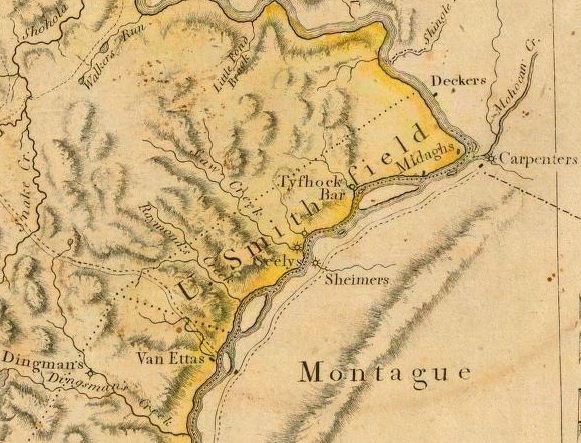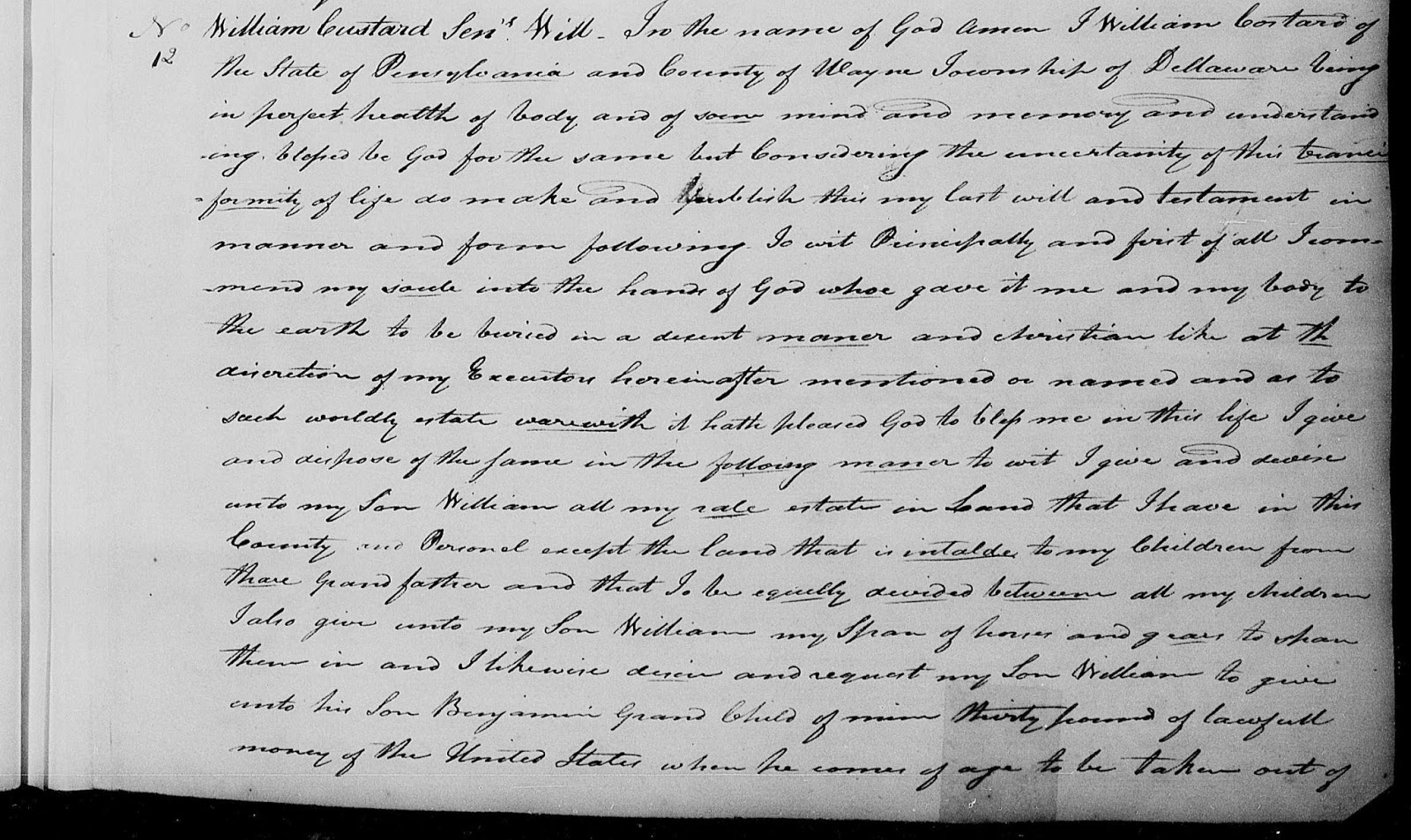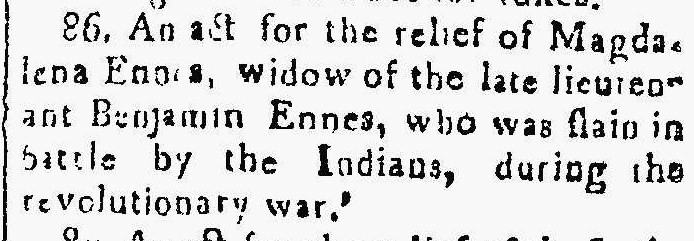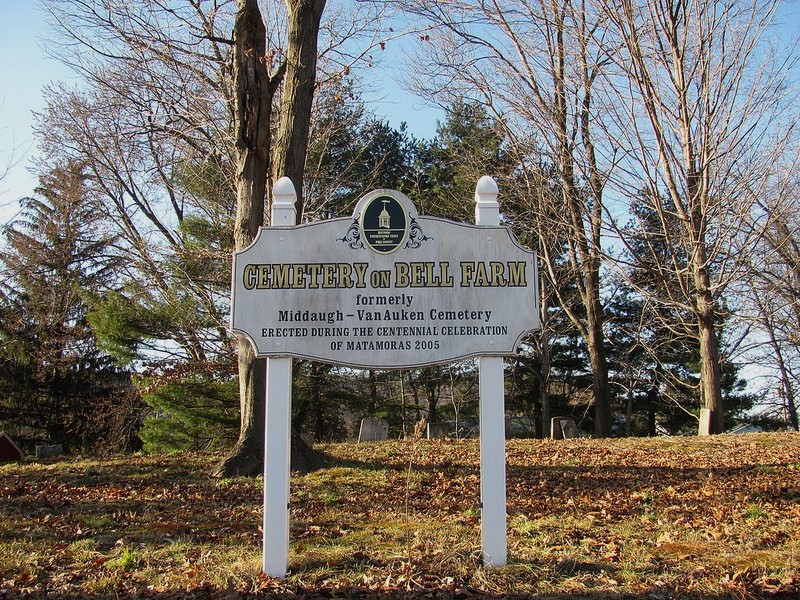In the course of research, I grew curious about the location of
Theeshacht or
Theeshact or Teeshachtee as dwelling places mentioned in the Marriage Register of the Minisink Valley Reformed Dutch Church
Records:





The pronunciation of
Theeshacht in Dutch reminded me of another mystery location from an early record of the Forts of Pennsylvania. In his 1756
instructions to Capt Vanetta [ transcript
pages 301 & 302] of the township of Upper Smithfield, Benjamin Franklin wrote:
For
the better Security of the Inhabitants of that District, you are to
post your men as follows: Eight at your own house [tract on the present day Conashaugh]
, Eight at Lieutenant
Henshaw’s, [Hyndshaw]
Six with a Serjeant at Tishhock ____, and
Six with another Serjeant at or near Henry Cortracht’s,[Courtright]
and
you are to settle Signals, or Means of Suddenly alarming the
Inhabitants, and convening your whole Strength with the Militia of your
District, on any necessary Occasion.
 |
| Ben Franklin's instructions to Capt. Vanetta |
A detail for Upper Smithfield in the 1792 Reading Howell
map of Pennsylvania locates the hamlet of
Tyshock Bar along a creek draining into the river opposite the south end of a large island which must be Mashipacong & Cummins Hill Creek. If so, this is also the site of the hamlet known as Quicktown in later histories of Westfall Township and the location of Cornelius DeWitt's land grant of 1749 (patented to Peter Quick in 1787).
 |
| Tyshock Bar, opposite the south end of Mashipacong Island |
Given the overwhelming use of Native American words in the naming
of early 18th c hamlets in the Minisink, it is possible
Theeshacht is the Dutch
spelling for a Native American descriptive term, perhaps later anglicized to
Tishhock. The editor of Deputy Surveyor of Pennsylvania George Palmer's
field notes of 1774 includes this intriguing reference to the place name
Tyshaw:

Are the locations of
Theeshacht in the c 1750 Dutch records, the site of
Tishhock in Ben Franklin's instructions of 1756, George Palmer's field note of 1774 on
Tyshaw and the 1792 hamlet of
Tyshock Bar, in present day Westfall Township, one and the same?
William Henn, in
Westfall Township, Gateway to the West, p17, states: "In 1730, Cornelius Van Aken (b 1690), who married Sara Westbrook (b. 1694) bought a tract of land below the ferry landing, and on this plantation known as
Theesacht several generations of Van Akens were reared. It was adjacent to another tract owned by Herman Rosen Krantz ... As was common among the sparse inhabitants, neighbors became in-laws, and in 1749, Abram C. Van Aken, son of Cornelius, married Catherine Rosen Kranz at Theesacht and made it their home."
Henn fails to note his sources but the PA State
Warrantee township map for Westfall finds the warrants for Cornelius Van Akin, key
W for 92 acres, 1750, situated in present day Matamoras, and close at hand that of Herman Rosegrand, key
U, 62 acres, 1751, situated along the present day Rosetown Creek. Additional mid-18th century warrants include the names of Johannes Cole and Tunis Middaugh.
An old burying ground presently called the Cemetery on Bell Farm and also known as Middaugh -Van Auken Cemetery is located on Ave Q, between 9th & 10th Streets in Matamoras. The earliest existing tombstone is that of John Van Auken who died in 1831, aged 73.
About a mile and a half south stands the earliest existing tombstone in the Rose
family burying ground that of Maria Hornbeek, wife of James Rosencrantz,
who died July 3d 1815 in the 75th year of her age.
 |
| Maria Hornbeek Rosencrantz, 1743-1815 |
Harkening back to the beginning paragraph of this rumination I think there's a line to be drawn between a
community (Minisink Dutch Reformed Church Records) or the Gallagher house also know as "Teesacht or Teasack", owned by Frederick B Marvin (Fluhr) or a
plantation (Henn). Fluhr & Henn both lack a period source but
possess a flavor, as it were, by using what must have been a community place
name as listed in the MDR Church Records.
Abram van Aken, Catharina
Rosenkrantz, Lisabeth van Aken, Benjamin Quick, Isaac Middagh, and
Arriaentje Rosenkranz are all listed as being
born at or
dwelling in Theeschacht in the marriage records of 1748 to 1754. Way too many folks to be living in one house or on a single plantation. (Note people were living in
Theeschacht before PA issued Warrants to
either Cornelius Vanaken, 1750, or Herman Rosegrand, surveyed in
1751.)
Which leaves the lay of the land to examine against the
Theeschacht
time period of the Warrants and including the "Y" Warrant for Tunis
Madock [Middagh] of 1749 which lies directly opposite the confluence of
the Delaware and Neversink, the ferry landing. Not too very far away
are "W" Van Akin [Vanaken] of 1750 (per Henn,
a tract of land below the ferry
landing) & "U" Rosegrand [Rosencrans/Rosenkrantz] of 1751 on the Westfall Township map (survey
shows his tract surrounded by vacant land.) Just up river from Middagh
are the earliest Cole tracts, "13" & "P" of 1749.
 |
| Warrants: "Y" Tunis
Madock [Middagh], 1747; "W" CorneliusVan Akin [Vanaken], 1750; "U" Herman Rosegrand [Rosencrans/Rosenkrantz] 1751. |
So, we have PA families living/farming/marrying in a small community
opposite the settlement & DRC of Magagkamack. Vosburgh lists
Sarah, wife of Cornelius Van Aken, d 1766 among those buried at the
Magagkamack graveyard. How
many, I wonder, of the
Theeshacht folk are buried there?
The19th c Edmund O'Callahan map mentioned in our most recent entry
Brodhead's Map of the 17th C New Netherlands Charters, refers to a settlement
T'schichte as found on
Van der Donck's map. Whether these Dutch families settled among the Indians or were informally granted a portion of land along the river flats, the place name
T'schichte may well be the origin of the Dutch church records place name
Theeshacht. Whether the earliest maps are accurate, given the location is further north, or if the European and Indian villages existed together or apart, remains a mystery.
A Note on
Tyscbag:
Additional, and later, records list: A marriage in 1757, Arriyantie Rosenkrans (widow) born at
Tyscbag; 1758, Helena Quick dwelling at
Tyscbag; and 1759, Jacobus Van
Aken born at
Tyscbag to Elizabeth Bunscoten, widow, and both dwelling
there. All these entries were written by Anthony Van Etten, JP, the
least literate of all the MDRC recorders. See
page 271.













